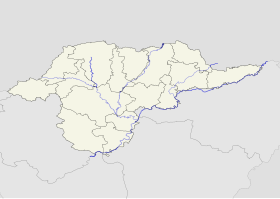55 페르세이
55 Persei| 관측 데이터 에폭 J2000 이쿼녹스 J2000 | |
|---|---|
| 별자리 | 페르세우스 |
| 우측 상승 | 04h 24m 29.1556s[1] |
| 탈위임 | +34° 07′ 50.728″[1] |
| 겉보기 크기 (V) | 5.73[2] |
| 특성. | |
| 스펙트럼형 | B8 V[2] |
| B-V색지수 | −0.054±0.004[2] |
| 아스트로메트리 | |
| 방사 속도 (Rv) | +8.5±3[3].5km/s |
| 고유 운동 (μ) | RA: +21.092 마스/yr Dec.: -34.137 마스/yr |
| 시차 (π) | 8.50 ± 0.38[4] 마스 |
| 거리 | 380 ± 20 리 (105 ± 5 pc) |
| 절대치수 (MV) | −0.39[5] |
| 세부 사항 | |
| 미사 | 3.44±0.07[6] M☉ |
| 반지름 | 3.0[7] R☉ |
| 루미도 | 193+24 −21[6] L☉ |
| 온도 | 12,246±85[6] K |
| 회전 속도 (v sin i) | 시속 288km[6] |
| 나이 | 197[5] 마이어 |
| 기타 지정 | |
| 데이터베이스 참조 | |
| 심바드 | 자료 |
55 페르세이는 페르세우스 북쪽 별자리에 있는 [9]청백색의 단일 별이다.잘 보이는 조건에서 육안으로 희미하게 볼 수 있으며, 겉으로 보이는 시각 크기는 5.73이다.[2]지구 궤도에서 볼 수 있는 연간 시차 변화량 8.50±0.38 mas를[4] 바탕으로, 이 별은 태양으로부터 약 380광년 떨어진 곳에 위치해 있다.그 거리에서는 성간 먼지로 인해 0.39의[5] 소멸로 시각적 크기가 감소한다.
이것은 B8 V의 별 분류를 가진 B형 주계열성으로,[2] 중심부에서 수소융합을 통해 에너지를 발생시키고 있는 거대한 별이다.태양의 3.44배[6], 태양의 반경 약 3배의 질량을 가지고[7] 있다.이 별은 약 1억[5] 7천 7백만 년 된 것으로, 288 km/s의 예상 회전 속도로 빠르게 돌고 있다.[6]그것은 12,246 K의 유효 온도에서 태양의 광도보다 약 193배[6] 더 많은 광도를 방출하고 있다.[6]
참조
- ^ a b c d Brown, A. G. A; et al. (2016), "Gaia Data Release 1. Summary of the astrometric, photometric, and survey properties", Astronomy and Astrophysics, 595, A2, arXiv:1609.04172, Bibcode:2016A&A...595A...2G, doi:10.1051/0004-6361/201629512, S2CID 1828208.
- ^ a b c d e Anderson, E.; Francis, Ch. (2012), "XHIP: An extended hipparcos compilation", Astronomy Letters, 38 (5): 331, arXiv:1108.4971, Bibcode:2012AstL...38..331A, doi:10.1134/S1063773712050015, S2CID 119257644.
- ^ de Bruijne, J. H. J.; Eilers, A.-C. (October 2012), "Radial velocities for the HIPPARCOS-Gaia Hundred-Thousand-Proper-Motion project", Astronomy & Astrophysics, 546: 14, arXiv:1208.3048, Bibcode:2012A&A...546A..61D, doi:10.1051/0004-6361/201219219, S2CID 59451347, A61.
- ^ a b van Leeuwen, F. (2007), "Validation of the new Hipparcos reduction", Astronomy and Astrophysics, 474 (2): 653–664, arXiv:0708.1752, Bibcode:2007A&A...474..653V, doi:10.1051/0004-6361:20078357, S2CID 18759600.
- ^ a b c d Gontcharov, G. A. (November 2012), "Spatial distribution and kinematics of OB stars", Astronomy Letters, 38 (11): 694–706, arXiv:1606.09028, Bibcode:2012AstL...38..694G, doi:10.1134/S1063773712110035, S2CID 119108982.
- ^ a b c d e f g h Zorec, J.; Royer, F. (2012), "Rotational velocities of A-type stars. IV. Evolution of rotational velocities", Astronomy & Astrophysics, 537: A120, arXiv:1201.2052, Bibcode:2012A&A...537A.120Z, doi:10.1051/0004-6361/201117691, S2CID 55586789.
- ^ a b Pasinetti Fracassini, L. E.; et al. (February 2001), "Catalogue of Apparent Diameters and Absolute Radii of Stars (CADARS)", Astronomy and Astrophysics (3rd ed.), 367 (2): 521–524, arXiv:astro-ph/0012289, Bibcode:2001A&A...367..521P, doi:10.1051/0004-6361:20000451, S2CID 425754.
- ^ "55 Per". SIMBAD. Centre de données astronomiques de Strasbourg. Retrieved 2018-03-08.
- ^ Eggleton, P. P.; Tokovinin, A. A. (September 2008), "A catalogue of multiplicity among bright stellar systems", Monthly Notices of the Royal Astronomical Society, 389 (2): 869–879, arXiv:0806.2878, Bibcode:2008MNRAS.389..869E, doi:10.1111/j.1365-2966.2008.13596.x, S2CID 14878976.



